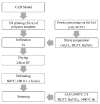Energy-Reduced Fabrication of Light-Frame Ceramic Honeycombs by Replication of Additive Manufactured Templates
- PMID: 37512201
- PMCID: PMC10381821
- DOI: 10.3390/ma16144924
Energy-Reduced Fabrication of Light-Frame Ceramic Honeycombs by Replication of Additive Manufactured Templates
Abstract
Ceramic components require very high energy consumption due to synthesis, shaping, and thermal treatment. However, this study suggests that combining the sol-gel process, replica technology, and stereolithography has the potential to produce highly complex geometries with energy savings in each process step. We fabricated light-frame honeycombs of Al2O3, Ba0.85Ca0.15Zr0.1Ti0.9O3 (BCZT), and BaTiO3 (BT) using 3D-printed templates with varying structural angles between -30° and 30° and investigated their mechanical and piezoelectric properties. The Al2O3 honeycombs showed a maximum strength of approximately 6 MPa, while the BCZT and BaTiO3 honeycombs achieved a d33 above 180 pC/N. Additionally, the BCZT powder was prepared via a sol-gel process, and the impact of the calcination temperature on phase purity was analyzed. The results suggest that there is a large energy-saving potential for the synthesis of BCZT powder. Overall, this study provides valuable insights into the fabrication of complex ceramic structures with improved energy efficiency and enhancement of performance.
Keywords: additive manufacturing; ceramic honeycombs; piezoelectric porous ceramics; replica method; sol–gel method.
Conflict of interest statement
The authors declare no conflict of interest.
Figures






References
-
- Bowen C., Perry A., Lewis A., Kara H. Processing and properties of porous piezoelectric materials with high hydrostatic figures of merit. J. Eur. Ceram. Soc. 2004;24:541–545. doi: 10.1016/S0955-2219(03)00194-8. - DOI
-
- Maeda K., Fujii I., Nakashima K., Fujimoto G., Suma K., Sukigara T., Wada S. Preparation of barium titanate porous ceramics and their sensor properties. J. Ceram. Soc. Jpn. 2013;121:698–701. doi: 10.2109/jcersj2.121.698. - DOI
-
- Yang A.-K., Wang C.-A., Guo R., Huang Y. Effects of porosity on dielectric and piezoelectric properties of porous lead zirconate titanate ceramics. Appl. Phys. Lett. 2011;98:152904. doi: 10.1063/1.3578196. - DOI
-
- Boumchedda K., Hamadi M., Fantozzi G. Properties of a hydrophone produced with porous PZT ceramic. J. Eur. Ceram. Soc. 2007;27:4169–4171. doi: 10.1016/j.jeurceramsoc.2007.02.124. - DOI
-
- Khansur N.H., Biggemann J., Stumpf M., Riess K., Fey T., Webber K.G. Temperature- and Stress-Dependent Electromechanical Response of Porous Pb(Zr, Ti)O3. Adv. Eng. Mater. 2020;22:2000389. doi: 10.1002/adem.202000389. - DOI
Grants and funding
LinkOut - more resources
Full Text Sources

